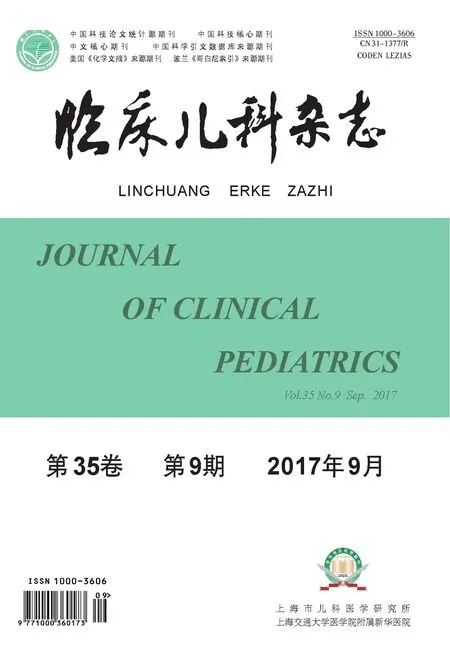儿童肾瘢痕形成的危险因素
孙 玉综述 沈 茜审校
复旦大学附属儿科医院肾脏科 上海市肾脏发育和儿童肾脏病研究中心(上海 201102)
·文献综述·
儿童肾瘢痕形成的危险因素
孙 玉综述 沈 茜审校
复旦大学附属儿科医院肾脏科 上海市肾脏发育和儿童肾脏病研究中心(上海 201102)
肾瘢痕可导致高血压、蛋白尿、慢性肾脏病、甚至终末期肾病的可能。研究儿童肾瘢痕形成的危险因素,有利于早发现、早诊断、早预防、早治疗。高级别的膀胱输尿管反流,反复的泌尿道感染,以及延误治疗都是肾瘢痕形成的危险因素。但是仍有一些因素,如性别和年龄,先天性因素与肾瘢痕的关系目前仍存在争议。近年研究发现,尿液无创指标,如尿中性粒细胞明胶酶相关脂质运载蛋白、尿内皮素-1及风险预测模型均可预测肾瘢痕的形成,而预防应用抗生素虽可减少泌尿道感染的发生,但并不能降低肾瘢痕形成的风险。文章综述了儿童肾瘢痕形成的可能危险因素和预测指标,为临床对肾瘢痕的早期发现、及时干预和有效预防提供依据,以期减少肾瘢痕的形成和进展。
肾瘢痕; 危险因素; 膀胱输尿管反流; 泌尿道感染; 儿童
国内外研究表明,肾瘢痕可导致高血压、蛋白尿、慢性肾脏病、甚至终末期肾病的发生[1-4]。本文就儿童肾瘢痕形成的可能危险因素和预测指标进行综述,为临床对肾瘢痕的早期发现、及时干预和有效预防提供依据,以期减少肾瘢痕的形成和进展。
1 膀胱输尿管反流(vesicoureteral reflux,VUR)
VUR与肾瘢痕形成密切相关,大多研究表明肾瘢痕的形成与反流程度相关,并且部分肾瘢痕形成是由于先天性因素引起。
1.1 反流程度
大多研究支持肾瘢痕的形成与VUR程度相关,且VUR级别越高,肾瘢痕形成的危险性就越大[5-7]。有研究表明,如果反流程度升高1级,肾瘢痕形成的危险性就升高3.5倍[8],近期有较多研究都证实了上述观点。研究发现,IV和V级 VUR儿童肾瘢痕发生的可能性是没有VUR儿童的22倍,相比之下,I级或II 级VUR儿童肾瘢痕发生的概率只略高于无VUR儿童[9]。通过对2~71月龄的607例在第一或第二次发热或有症状的泌尿道感染(UTI)后诊断为I~IV级VUR的患儿进行为期2年的,多中心、随机、安慰剂对照试验,结果发现IV级VUR患儿比低级别或无VUR者更易出现肾瘢痕[10]。同时,研究者也认为IV、V级反流是肾瘢痕形成的最具价值的预测指标[11]。但国内学者回顾性研究1990—2002年间的50例儿童原发性VUR,并对反流程度进行Kruskal-Waillis检验显示肾瘢痕与反流程度无显著相关[12]。
1.2 年龄和性别
VUR患儿的年龄和性别与肾瘢痕形成的关系仍存争议。国内研究者回顾分析974例UTI患儿中的139例原发性VUR患儿,发现50例肾瘢痕患儿中30例(60.0%)的年龄在2岁以内[13]。国外研究者对607例2~71月龄且在第一或第二次发热或伴有症状的UTI后诊断为I~IV级VUR的患儿进行为期2年的随访中发现,肾瘢痕形成组的中位年龄高于无肾瘢痕形成组(26个月对11个月,P=0.01)[10];亦有研究表明,诊断VUR时>5岁及男性是肾瘢痕形成最有意义的危险因素[14]。在性别与肾瘢痕形成的关系研究中,还有学者发现,女性患儿肾瘢痕的形成多与反复发热性UTI发生相关,而男性患儿肾瘢痕的形成多与反流及其程度相关[15]。
1.3 先天性肾瘢痕
VUR与先天性肾瘢痕的关系还存在争议,可能与压力性改变、先天性肾发育异常或两者共同作用所致。近期研究推测,先天性肾瘢痕通常由于膀胱动力学显著改变引起肾脏发育异常所致[4]。膀胱高压破坏了膀胱黏膜屏障的完整性并使黏膜血流受阻,而反流尿液中的Tamm-Horsfall蛋白等可能诱发免疫损伤,出现肾小球局灶性硬化[16,17]。动物实验表明,持续一定时间的膀胱内高压可引起肾瘢痕形成[18]。膀胱输尿管反流与先天性肾瘢痕的关系有待进一步研究。
2 泌尿道感染
UTI尤其是有症状的UTI,被认为与儿童肾瘢痕的形成相关[10,19],延误治疗和反复感染是肾瘢痕形成的危险因素。
2.1 延误治疗
有研究者在第一次发热性UTI的230例患儿中发现,伴有肾瘢痕形成的患儿出现症状至开始使用抗生素的时间明显长于无肾瘢痕形成的患儿,延误治疗与肾瘢痕的形成密切相关[20]。
2.2 反复感染
反复的UTI尤其是反复的肾盂肾炎是肾瘢痕形成的关键危险因素。有研究在不伴有泌尿道梗阻的74例肾瘢痕患儿中发现,反复发生发热性UTI的女性患儿更易出现肾瘢痕[15]。在另一项对303例患儿进行的回顾性研究发现,肾瘢痕的形成和发展与反复发热性UTI的次数具有相关性[21]。
2.3 年龄和性别
UTI患儿的年龄、性别与肾瘢痕关系仍不明确。在对伴有VUR的泌尿道感染患儿的回顾性研究中发现,男性(OR值2.5),≥27个月的女性患儿(OR 值4.2)是肾瘢痕形成的独立危险因素[11]。国内对106例UTI患儿的回顾性分析发现,≤2岁组肾瘢痕发生率高[22]。但在对0~18岁第一次发生UTI接受99mTc DMSA检查并随访至少5个月的患儿进行的meta分析显示,肾瘢痕的发生率在不同年龄和性别间无明显差异[9]。
3 其他因素
3.1 尿液无创指标
近期研究表明,一些无创尿液指标可有效预测肾瘢痕的形成。研究发现,尿中性粒细胞明胶酶相关脂质运载蛋白(NGAL)/肌酐比值在伴有肾瘢痕的患儿中显著增高,因此推测尿NGAL水平可作为预测反流性肾病肾瘢痕的非侵入性无创诊断指标[23]。另一项研究发现,尿内皮素-1和尿内皮素-1/肌酐比值均可以预测肾功能正常患儿的肾瘢痕[24]。
对尿液细胞因子的研究发现,大多肾瘢痕患儿中尿白细胞介素-6(IL-6)水平较明显增高,且与是否合并VUR无显著相关性。尿IL-6水平越高,肾瘢痕形成时间越短[25]。此外,亦有关于尿IL-8与肾瘢痕关系的研究,但结果显示尿IL-8水平并不能预测肾瘢痕的形成[25-29],但可较好地预测高级别VUR的存在[28]。
3.2 肾瘢痕形成预测模型
建立风险预测模型可指导临床判断肾瘢痕形成的危险因素[9]。有meta分析显示,在年龄0~18岁、首次UTI、感染至少5个月以后99mTc DMSA随访肾瘢痕形成的患儿中,建立3个模型:模型1[临床(人口统计学信息、发热和病原微生物)+肾脏超声]、模型2[模型1参数 +血清炎症指标(CRP+中性粒细胞计数)]、模型3(模型2 参数+MCU),模型2和模型3比模型1对肾瘢痕形成的预测能力仅分别增加3%和5%。因而建议将非大肠埃希菌感染伴高热或肾脏超声异常作为肾瘢痕形成的危险因素 。
3.3 干预因素对肾瘢痕的影响
预防应用抗生素对预防反复发热的UTI具有显著的意义[27],但是预防应用抗生素并不能降低肾瘢痕形成的风险[10]。另有研究显示,维生素A可能对儿童急性肾盂肾炎的肾脏损害有预防作用,维生素A干预组肾脏损害发生率低于对照组(相对危险度 0.53,95%可信区间 0.43,0.67)[29]。
综上所述,肾瘢痕形成的危险因素较多,部分还存在一定的争议,期待有更多大样本多中心的随机对照研究。如前所述肾瘢痕形成会引起高血压及慢性肾脏病,少数患儿最终可发展为终末期肾病。因此,早期诊断及防治有重要的价值和意义
[1]黄锡年, 黄建萍, 杨霁云. 小儿肾瘢痕形成的有关问题[J].中华儿科杂志, 2000,38(5): 328.
[2]Kronbichler A, Leierer J, Oh J, et al. Immunologic changes implicated in the pathogenesis of focal segmental glomerulosclerosis [J]. Biomed Res Int, 2016,2016:2150451.
[3]Peters C, Rushton HG. Vesicoureteral reflux associated renal damage: congenital reflux nephropathy and acquired renal scarring [J]. J Urol, 2010, 184(1): 265-273.
[4]Kuma A, Tamura M, Otsuji Y. Mechanism of and therapy for kidney fibrosis [J]. J UOEH, 2016, 38(1): 25-34.
[5]Benador D, Benador N, Slosman D, et al. Are younger children at highest risk of renal sequelae after pyelonephritis?[J]. Lancet, 1997, 349(9044): 17-19.
[6]Ditchfield MR, Grimwood K, Cook DJ, et al. Persistent renal cortical scintigram defects in children 2 years after urinary tract infection [J]. Pediatr Radiol, 2004, 34(6): 465-471.
[7]Zaffanello M, Franchini M, Brugnara M, et al. Evaluating kidney damage from vesico-ureteral reflux in children [J].Saudi J Kidney Dis Transpl, 2009, 20(1): 57-68.
[8]Ismaili K, Avni FE, Wissing KM, et al. Long-term clinical outcome of infants with mild and moderate fetal pyelectasis:validation of neonatal ultrasound as a screening tool to detect significant nephrouropathies [J]. J Pediatr, 2004, 144(6): 759-765.
[9]Shaikh N, Craig JC, Rovers MM, et al. Identification of children and adolescents at risk for renal scarring after a first urinary tract infection: a meta-analysis with individual patient data [J]. JAMA Pediatr, 2014, 168(10): 893-900.
[10]Mattoo TK, Chesney RW, Greenfield SP, et al. Renal scarring in the randomized intervention for children with vesicoureteral reflux (RIVUR) trial [J]. Clin J Am Soc Nephrol, 2016, 11(1): 54-61.
[11]Soylu A, Demir BK, Türkmen M, et al. Predictors of renal scar in children with urinary infection and vesicoureteral reflux [J]. Pediatr Nephrol, 2008, 23(12): 2227-2232.
[12]饶佳, 徐虹, 阮双岁, 等. 小儿原发性膀胱输尿管反流的临床研究[J]. 中国实用儿科杂志, 2004, 19(8): 465-467.
[13]王臻, 徐虹, 刘海梅, 等. 139例小儿原发性膀胱输尿管反流临床分析[J]. 中华儿科杂志, 2008, 46(7): 518-521.
[14]Vachvanichsanong P, Dissaneewate P, Thongmak S, et al.Primary vesicoureteral reflux mediated renal scarring after urinary tract infection in Thai children [J]. Nephrology(Carlton), 2008, 13(1): 38-42.
[15]Wennerstrom M, Hansson S, Jodal U, et al. Primary and acquired renal scarring in boys and girls with urinary tract infection [J]. J Pediatr, 2000, 136(1): 30-34.
[16]Gordon I, Barkovics M, Pindoria S, et al. Primary vesicoureteric reflux as a predictor of renal damage in children hospitalized with urinary tract infection: a systematic review and meta-analysis [J]. J Am Soc Nephrol, 2003, 14(3): 739-744.
[17]饶佳, 徐虹. 小儿原发性膀胱输尿管反流及其肾病的研究进展[J]. 国外医学(儿科学分册), 2004, 31(1): 18-20.
[18]吕路, 黄锋先. 膀胱输尿管反流与肾瘢痕形成[J]. 国外医学(泌尿系统分册), 2001, 21(3): 111-112.
[19]Yildiz B, Poyraz H, Cetin N, et al. High sensitive C-reactive protein: a new marker for urinary tract infection, VUR and renal scar [J]. Eur Rev Med Pharmacol Sci, 2013, 17(19):2598-2604.
[20]Oh MM, Kim JW, Park MG, et al. The impact of therapeutic delay time on acute scintigraphic lesion and ultimate scar formation in children with first febrile UTI [J]. Eur J Pediatr,2012, 171(3): 565-570.
[21]Swerkersson S, Jodal U, Sixt R, et al. Relationship among vesicoureteral reflux, urinary tract infection and renal damage in children [J]. J Urol, 2007, 178(2): 647-651.
[22]卫敏江, 吴伟岚, 沈加, 等. 儿童泌尿道感染中膀胱输尿管反流发生率的临床研究[J]. 临床儿科杂志, 2007, 25(9):776-778.
[23]Parmaksiz G, Noyan A, Dursun H, et al. Role of new biomarkers for predicting renal scarring in vesicoureteral reflux: NGAL, KIM-1, and L-FABP [J]. Pediatr Nephrol,2016, 31(1): 97-103.
[24]Yilmaz A, Gedikbasi A, Sevketoglu E, et al. Urine endothelin-1 levels as a predictor of renal scarring in children with urinary tract infections [J]. Clin Nephrol, 2012, 77(3): 219-224.
[25]Tramma D, Hatzistylianou M, Gerasimou G, et al. Interleukin-6 and interleukin-8 levels in the urine of children with renal scarring [J]. Pediatr Nephrol, 2012, 27(9): 1525-1530.
[26]Badeli H, Khoshnevis T, Hassanzadeh Rad A, et al. Urinary albumin and interleukin-8 levels are not good indicators of ongoing vesicoureteral reflux in children who have no active urinary tract infection [J]. Arab J Nephrol Transplant, 2013,6(1): 27-30.
[27]Mathews R, Mattoo TK. The role of antimicrobial prophylaxis in the management of children with vesicoureteral reflux--the RIVUR study outcomes [J]. Adv Chronic Kidney Dis, 2015,22(4): 325-330.
[28]Merrikhi AR, Keivanfar M, Gheissari A, et al. Urine interlukein-8 as a diagnostic test for vesicoureteral reflux in children [J]. J Pak Med Assoc, 2012, 62(3 Suppl 2): S52-S54.
[29]Zhang GQ, Chen JL, Zhao Y. The effect of vitamin A on renal damage following acute pyelonephritis in children: a metaanalysis of randomized controlled trials [J]. Pediatr Nephrol,2016, 31(3): 373-379.
Risk factors for renal scarring in children
Reviewer: SUN Yu, Reviser: SHEN Qian (Department of Nephrology,Children's Hospital of Fudan University, Shanghai Kidney Development & Pediatric Kidney Disease Research Center, Shanghai 201102, China)
Renal scarring can cause hypertension, proteinuria, chronic kidney disease, and even end stage renal disease. To understand the risk factors of renal scarring in children is helpful for its early detection, diagnosis, prevention, and treatment. High grade vesicoureteric reflux, recurrent urinary tract infection, and delayed treatment are risk factors for kidney scarring. However,there are still some controversies about the relationship between renal scarring and the some factors such as gender, age, and congenital factors. Recent studies have found that noninvasive urine indicators such as urine neutrophil gelatinase associated lipid delivery protein, urinary endothelin-1, and risk prediction models can predict the formation of renal scar. However, prophylactic use of antibiotics can reduce occurance of urinary tract infections, but do not reduce the risk of renal scarring. This article reviews the possible risk factors and predictors of renal scarring in children, providing a basis for early detection, timely intervention, and effective prevention of it in clinic, so as to reduce the formation and progression of renal scarring.
renal scarring; risk factors; vesicoureteric reflux; urinary tract infection; child
2016-11-25)
(本文编辑:梁 华)
10.3969/j.issn.1000-3606.2017.09.019

